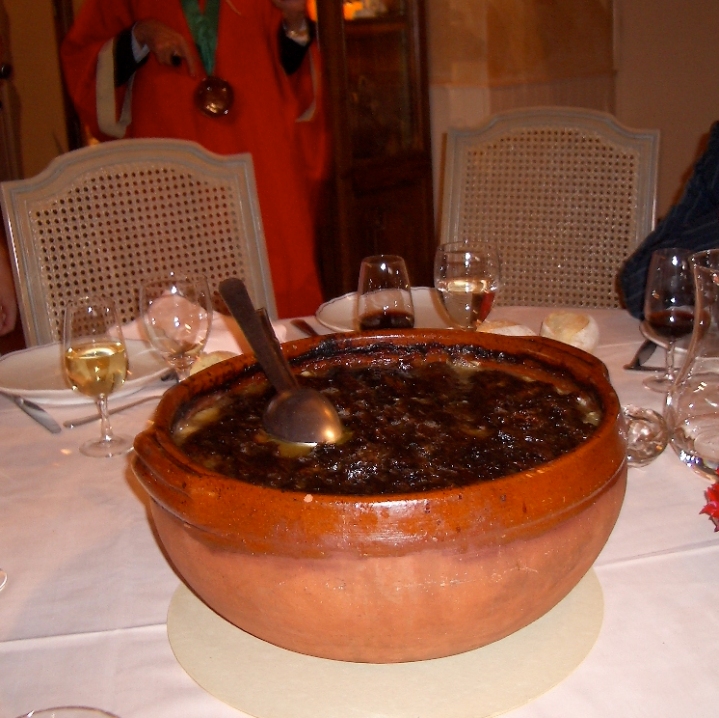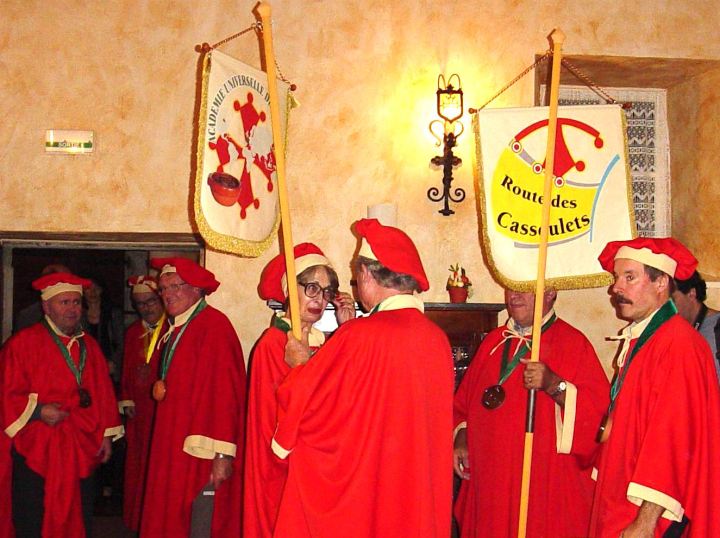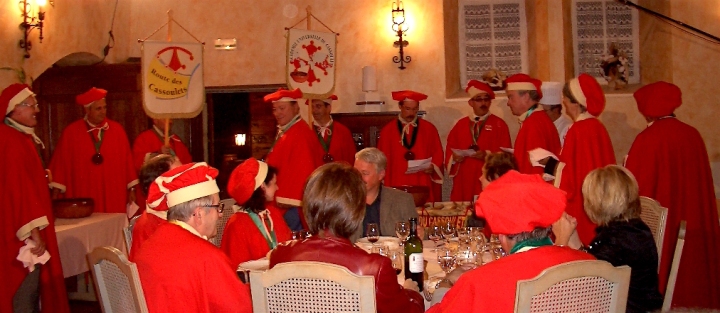
A horn sounds, and the ancient wood door swings open. A dozen men and women wearing red robes and hats file in, forming a semicircle. The initiate walks into the center of the group, takes his vow and is swathed in a red robe. A green ribbon with the group’s charm is placed around his neck. The members break into celebration.
This cabal isn’t for witchcraft. It’s a meeting of the Universal Academy of Cassoulet.
The charm: a tiny cassole, the clay pot for making cassoulet. The vow: When asked “is the cassoulet good,” the initiate replies, “Aco v’aimi!” which is Occitan for “I like that.” No, not occult. Occitan. The ancient language of the south of France. Oc was the way folks in these parts said “yes,” so the region is the Langedoc—the language of oc. As opposed to the north, where they said “oïl.”
 After the vow, the man who came up with the academy, chef Jean-Claude Rodriguez, is asked to give a speech. “Me? I have nothing to say!” he sputters. Then, he exclaims, “Aperitif!” Applause (and glasses of bubbly) all around.
After the vow, the man who came up with the academy, chef Jean-Claude Rodriguez, is asked to give a speech. “Me? I have nothing to say!” he sputters. Then, he exclaims, “Aperitif!” Applause (and glasses of bubbly) all around.
Rodriguez and some friends created the academy to promote true cassoulet around the world. The group’s bible is “Le Festin Occitan,” by Carcassonne native Prosper Montagné, who also wrote the first Larousse Gastronomique.
“The real cassoulet is hidden behind business. It’s hidden by a world that goes too fast. It’s hidden because we don’t have time to cook with tradition,” Rodriguez said in an interview I did with him a while back.
According to legend, cassoulet was created during the Hundred Years’ War with the British. During a siege at Castelnaudary in southern France, food was running low. The people were asked to contribute whatever they had, and the result was good: beans, duck, pork. But it’s a laborious process, taking two days to do it right.
As a result, many people now make it only a couple of times a year or they buy it canned or order it at restaurants. This is what drives the Academy. A firm denunciation of “industrial” cassoulet and a crusade to see that what’s made in restaurants is up to standards.
“In the beginning, we had lots of member restaurants,” says Jean Ramond, a founding Academy member. “Five or six of us would visit the restaurants, incognito, and order cassoulet. One would sneak into the kitchen, one would check the other rooms, another the toilets. Does the restaurant live up to our standards? We had to eliminate some,” he says, shaking his grizzled head sadly.
The group has “embassies” in several countries, including Japan and Singapore. There is just one in the U.S., in New York. It’s hard to find places that can comply with the charter, namely respecting French tradition and using fresh ingredients.
 “Over the years, the ingredients have less flavor,” says Academy member Alphonse Caravaca, a man whose booming laugh, mischievous eyes and thick, black moustache mark him immediately as a bon vivant, despite his métier in insurance (his title is “protagoniste avéré,” or proven protagonist, on the Academy’s administrative council). “The pork, the duck are raised differently. Industrially. You have to get back to the land to get the flavor.”
“Over the years, the ingredients have less flavor,” says Academy member Alphonse Caravaca, a man whose booming laugh, mischievous eyes and thick, black moustache mark him immediately as a bon vivant, despite his métier in insurance (his title is “protagoniste avéré,” or proven protagonist, on the Academy’s administrative council). “The pork, the duck are raised differently. Industrially. You have to get back to the land to get the flavor.”
“When we get together, conviviality grows,” Caravaca continues. “The table, the table is a big party. People don’t eat together anymore. Maybe we’re dinosaurs, I don’t know.”
The horn sounds again. Two men enter with a giant, steaming cassole on a litter. This meeting of the Academy is held in Rodriguez’s restaurant, Chateau St. Martin Trencavel, near Carcassonne. As the main critic of inferior cassoulets, and in the midst of a group of self-professed worshipers of the dish, he has a lot at stake with the evening’s dinner. Not to fear. The black crust is rich, the portions of duck generous, the beans tender.
“I like the beans best,” confides Ramond, the ex-arms dealer. “They soak up all the other flavors.”
The noise level drops markedly as the members concentrate on their plates. After a dessert featuring thyme ice cream and peaches and coffee, the meeting draws to a close. Pierre Poli, the grand master, cites Montagné: “Cassoulet is the god of Occitan cuisine, with Castelnaudary the father, Carcassonne the son and Toulouse the holy spirit. Have you found paradise?”
“Aco v’aimi!” the group cries. “I like that!”

Hello. I can not figure out how to comment on your blog. It seems different than others. Love your writing…..also your comments on other blogs. My husband and I were in your Area last year for the first time. We will be driving through again in October.
We brought home one of those large tins of Cassoulet last year. One of the reasons we are Returning is because my husband wants to eat in the area again. I want to buy some of the great bowls.
We live in the Pacific North West on a small island of the coast of Canada….called Salt Spring Island. We have been fortunate to have been able to travel to France every year for the last 5 years….for 2months at a time…..yes we are madly in love with France.
That’s it for now…
Ali Fenske
Sent from my iPad
>
LikeLike
Oh dear. As you can see, I am rather new with this blog and I just use the standard format. But this comment came through! Actually we do eat the canned cassoulet–it’s handy when you’ve been busy all day and just want to throw something in the oven for dinner. But while it isn’t bad, it’s NOTHING like the restaurants….or my friends’ cassoulets. It’s like a McDonald’s hamburger vs. a homemade burger on the grill. I haven’t been to your part of Canada but it sounds beautiful. I hope you do return! Let me know if you come to Carcassonne!
LikeLike
Bonjour! We will be traveling through your area this May and wonder if you can recommend a few places to eat? A restaurant within the walls for lunch would be wonderful. We will be staying in Caunes Minervois. So anything that might work for dinner would be terrific too. We are so excited about our trip to France and especially exploring “The Other South of France”.
Merci,
Ann
LikeLike
There are some good places to eat in Caunes (which is a GORGEOUS village!): the restaurant in the Hotel d’Albert is excellent; so is La Marberie. And I haven’t been to la Table d’Emilie, but she catered a wonderful meal for some friends.
In la Cité, Le Jardin de la Tour is very good, as is La Barbacane. However, with so many tourists, too many places feel they don’t have to make the effort to be great. You’ll find better food outside the walls. Our favorite restaurant is le Clos Framboisier, in a lotissement where you would least expect to find an old stone farmhouse and a courtyard full of giant palm trees around a pool. The food there is consistently wonderful, and while the menu isn’t big (it changes often), there is something for everyone, from the serious carnivore to the no-meat-thanks health nut. Up in the mountains from Caunes, there’s l’Oustal, which is a tiny place and you need to reserve. Or in Lastours (whose ruins aren’t to be missed), there’s le Puits du Trésor.
I intend to post about restaurants, wineries and things to do in town (i.e., for train/plane arrivals who don’t have a car) and those farther out where a car is needed.
LikeLike